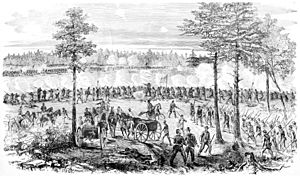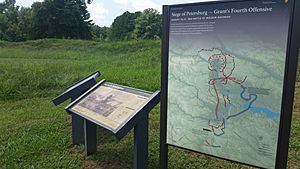Second Battle of Ream's Station facts for kids
Quick facts for kids Second Battle of Ream's Station |
|||||||
|---|---|---|---|---|---|---|---|
| Part of the American Civil War | |||||||
 Contemporary engraving showing the final repulse of the Confederate assault |
|||||||
|
|||||||
| Belligerents | |||||||
| Commanders and leaders | |||||||
| Winfield S. Hancock | A. P. Hill Henry Heth |
||||||
| Strength | |||||||
| 9,000 | 8,000–10,000 | ||||||
| Casualties and losses | |||||||
| 2,747 (Killed 140 Wounded 529 Captured 2073) |
814 | ||||||
The Second Battle of Ream's Station happened during the American Civil War on August 25, 1864. It was part of the long siege of Petersburg in Dinwiddie County, Virginia.
A Union army group led by Major General Winfield Scott Hancock was trying to destroy a very important railroad. This railroad, called the Petersburg Railroad, brought supplies to General Robert E. Lee's Confederate army in Petersburg, Virginia.
General Lee sent Confederate troops, led by Lieutenant General A. P. Hill, to stop Hancock. The Confederates managed to push the Union soldiers out of their defenses at Ream's Station. Even though the Confederates won this battle, the Union army still managed to damage a key part of the railroad. This made it harder for the Confederates to get supplies for the rest of the war around Richmond and Petersburg.
Contents
Why This Battle Happened
As the siege of Petersburg continued, Union Lieutenant General Ulysses S. Grant wanted to cut off all the railroads. These railroads were vital for supplying the city of Petersburg, General Lee's army, and the Confederate capital of Richmond.
The Important Railroads
One of the most important supply lines was the Petersburg Railroad. It went south to Weldon, North Carolina. From there, it connected to another railroad that led to Wilmington, North Carolina. Wilmington was the Confederacy's last major port.
Earlier, in June 1864, Union troops had tried to destroy parts of this railroad. In August, another Union group destroyed miles of track. This forced the Confederates to carry their supplies by wagon for about 30 miles (48 km). This was inconvenient, but not yet a huge problem for them.
Grant's Plan to Cut Supplies
General Grant wanted the Petersburg Railroad completely shut down. He planned to destroy about 14 miles (23 km) of track. He chose Hancock's II Corps for this mission. These soldiers were tired from recent fighting and long marches. Grant also added a cavalry division led by Brigadier General David McMurtrie Gregg to Hancock's forces.
On August 22, Gregg's cavalry and Union infantry began destroying the tracks. They got within 2 miles (3 km) of Ream's Station. The next day, Hancock's other division occupied Ream's Station. They used old earthworks, which were like dirt walls for defense. However, these defenses were in bad shape and the Union soldiers didn't fix them much.
Lee's Response
General Robert E. Lee saw the Union troops at Ream's Station as a big threat. If the nearby town of Dinwiddie Court House fell, the Confederates might have to leave both Petersburg and Richmond. This town was important for their retreat route.
Lee also saw a chance to win a big victory against the Union army. This could be important before the presidential election in November. He ordered Lieutenant General A. P. Hill to lead an attack. Hill's force included cavalry and infantry, totaling about 8,000 to 10,000 men. Hill was sick, so he put Major General Henry Heth in charge of the actual fighting. He told Heth, "You must take the position."
Hancock arrived at Ream's Station on August 24. By that evening, his troops had destroyed 3 miles (5 km) of track south of the station. On the morning of August 25, they left their defenses to destroy more track. But Hancock called them back when he heard Confederate cavalry were coming.
The Battle Begins
Confederate cavalry first pushed back Gregg's Union cavalry. Then, Hill's main force advanced. Around 2 p.m. on August 25, Confederate infantry attacked the Union defenses. They attacked twice but were pushed back by Union soldiers. Meanwhile, Confederate cavalry tried to go around the Union lines.
During these attacks, Major General George Meade, who was in charge of the Union Army of the Potomac, became worried. He thought Lee might be trying to get around the Union army's side. Meade was careful and sent more troops to his flank, which meant his own lines became thinner. He didn't send reinforcements to Hancock, trusting him to hold his position.
Fierce Fighting and a Breakthrough
More Confederate troops arrived. Their artillery, led by Colonel William Pegram, fired heavily at the Union defenses. The final attack began around 5:30 p.m. Six Confederate brigades attacked the Union position. They broke through the northwest part of the Union defenses.
Even though the Union soldiers fought fiercely, two of their regiments suddenly panicked and ran away. This created a gap in their lines. A Union general ordered his reserve troops to fill the gap, but they refused to fight. General Heth personally led the charge through the defenses.
Hancock rode around, trying to get his men to fight. His horse was hit and fell, but then got up, and Hancock remounted. He shouted, "We can beat them yet. Don't leave me, for God's sake!" He was very upset to see his once-proud soldiers unwilling to fight. He told a colonel, "I do not care to die, but I pray God I may never leave this field."
At the same time, Confederate cavalry attacked the Union infantry from the south. Many Union soldiers ran or surrendered. This allowed the Confederates to get around the side of the Union lines. Hancock ordered a counterattack. This gave his troops enough time to retreat in an orderly way back to Petersburg after dark.
What Happened After the Battle
The Union army lost 2,747 soldiers. This included 140 killed, 529 wounded, and 2,073 captured or missing. The Confederates lost 814 soldiers.
Even though the Confederates won the battle, they lost a very important part of the Petersburg Railroad. From then on, they could only transport supplies by train as far as Stony Creek Depot, which was 16 miles (26 km) south of Petersburg. From there, supplies had to be unloaded and carried by wagons. This made it much harder to get food and supplies to Petersburg and Lee's army.
General Grant and Meade were mostly happy with the results of their efforts against the railroad. Even though Hancock's troops had a tough loss, the Union army had achieved its main goal of damaging the supply line. The siege of Petersburg and its trench warfare continued.
Battlefield Preservation
Groups like the American Battlefield Trust have worked to save parts of the Ream's Station battlefield. They have protected about 293 acres (1.19 km²) of this historic land. In Spanish: Segunda batalla de Ream's Station para niños
In Spanish: Segunda batalla de Ream's Station para niños


